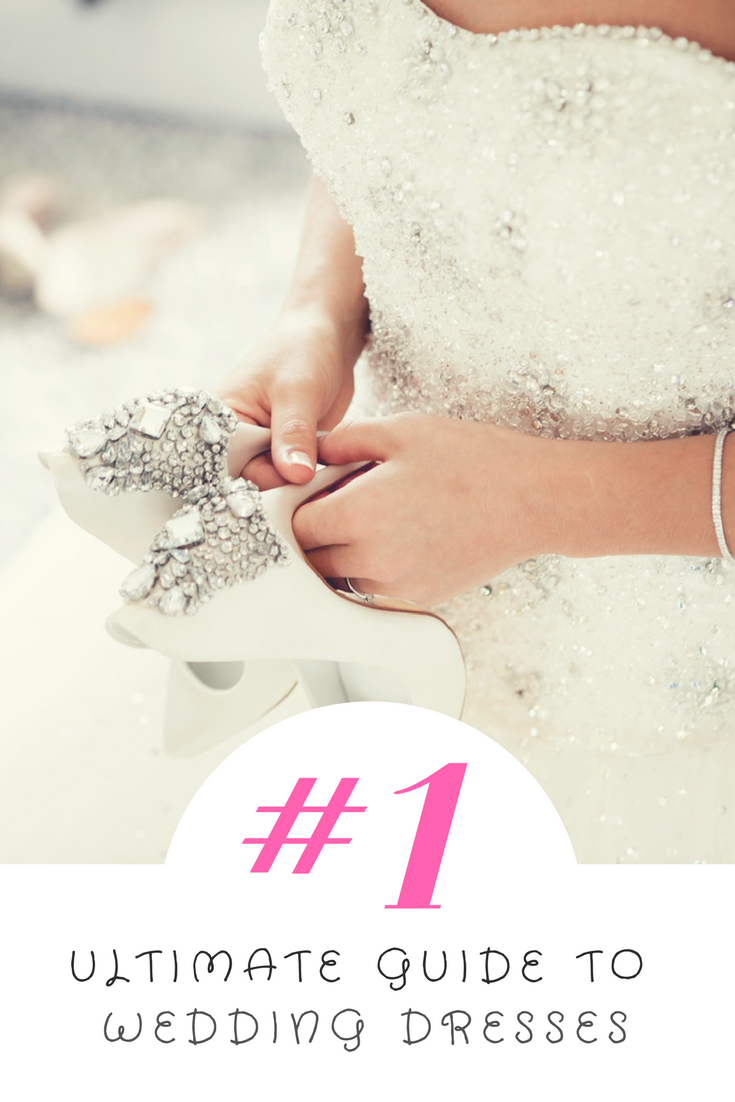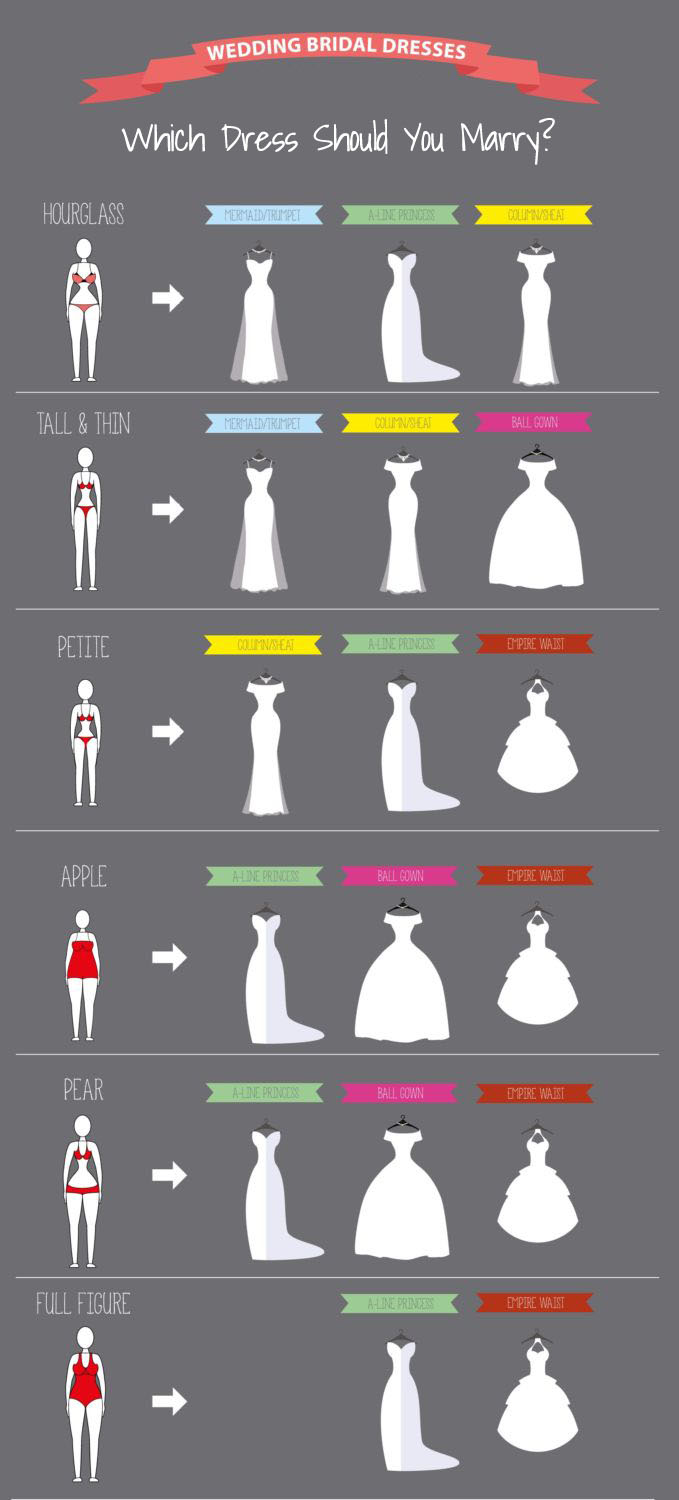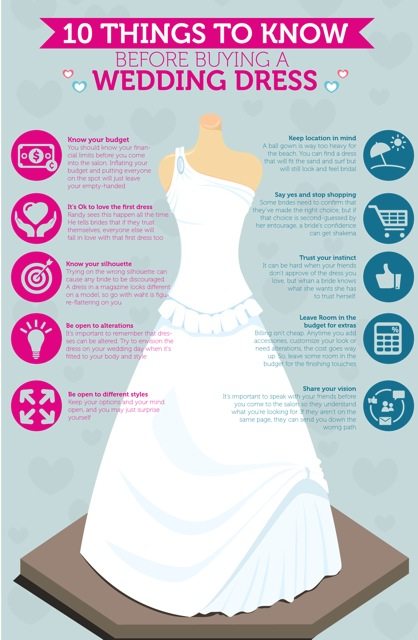There’s no other tradition as synonymous with marriage as the white wedding gown. And for some brides, the process started years ago. Are you the bride who started looking for your wedding dress before you were even engaged? You’re not alone. Most brides have thought about walking down the aisle in their wedding dress for years, probably envisioning the entire process of trying on dozens of dresses and falling in love with “the one”.
While the daydreams are nice, the reality is that wedding gown shopping can be a little overwhelming. We pulled together our ultimate guide the wedding dresses and our ongoing wedding dress blog posts as a way to help brides with their wedding planning process. When you think about what is involved in finding a wedding dress you can see how things quickly get stressful. You need to find out the basic cheat sheet for wedding gowns, understand the basic dress silhouettes and body types so you can understand how they flatter your figure and then you need to find a place to buy your wedding dress.
If you’re feeling pressure to find the wedding dress of your dreams then read this ultimate guide to wedding dresses and take your time. Don’t worry and don’t rush. We chatted with experts and brides who know exactly how you’re feeling, and we asked them to spill their tips for finding the perfect wedding dress. Read on, stress less and spend more time on the rest of your wedding planning to-do list.
Top Wedding Dress Do’s & Don’ts
- DO Learn the wedding dress shopping lingo: Know your “Gown Vocabulary” before you go to your appointment so that you are sure you and the consultant are on the same page. Click here for Team Wedding’s ultimate list of wedding dress shopping lingo.
- DON’T Bring a Huge Entourage: When was the last time a group of women were all in the same room and all agreed with each other? Never! Don’t have too many people with you when shopping for your wedding dress, it is going to be a real disaster. Read more.
- DO Take Advantage of Bridal Consultants: Bridal consultants know what they’re doing. They know what they have in stock, they’ve seen every size and shape bride you can imagine, and they know how to flatter any body type. Read more.
- DO Take Pictures: Take pictures of yourself in the wedding dresses to make sure they look the way you want. Don’t just take stand up photos either, you’re going to have to pose in the dress so move around. Read more.
- DON’T Limit Yourself to One Style: A different silhouette or material may flatter you better so don’t box yourself with one style and potentially miss your dream dress. Try on styles you’re unsure about, you never know. Read more.
- DON’T Wear The Wrong Underwear: This is one most brides don’t even think about until it is embarrassingly too late. The simple rule is to make sure you wear nice underwear. The bridal consultant and likely your friends are going to see you in them, so make the effort. Read more.
- DON’T Forget About The Extras: Ever bought a car and they add on extras till you look at the final tally and the price has almost doubled from the base price. Wedding gowns work the same way. The dress is just one part of the cost. Read more.
- DO Remember Your Budget, Always: This is a no-brainer. Don’t try on dresses you can’t afford. The simple law of attraction says you’re going to fall in love with the dress you can’t have and then you’re only setting yourself up for failure. Don’t do it. Read more.
- DO Move Around A Lot: You’re not going to just stand on a podium and look at your self in the mirror at your wedding. Between walking down the aisle, some photos, sitting down to eat and lots of dancing, you’re going to be moving around a lot.
- DO Have Fun: This is a once in a lifetime experience. Don’t get stressed out about finding a dress. Enjoy yourself and have some fun.
MORE WEDDING DRESS PICTURES. See lots more gorgeous dresses in our inspirational wedding dress picture gallery. Also, see our favorite wedding dresses on our wedding dress Pinterest board and find wedding dress designers.
Wedding Dress Terms To Know
At the end of the day, this cheat sheet of wedding dress terms is going to help you walk into an appointment with the ultimate level of confidence. You’re going to have a much better experience asking to try on the A-line gown with chapel train and Bobbin lace, than pointing to a sea of white dresses and asking to “try that white gown in the corner”.
Wedding Veils
- Blusher: loose veil worn forward over face and, after the ceremony, turned back.
- Flyaway: multiple layers that brush the shoulders; usually worn with an informal dress.
- Fingertip: several layers of veiling that touch the fingertips.
- Ballet-length/Waltz-length: falls to the ankles.
- Chapel-length: cascades 2 1/3 yards from headpiece.
- Cathedral-length: cascades at least 3 1/2 yards from headpiece.
Wedding Dress Necklines
- High: high band collar; fits close to neck.
- Sabrina: gently follows the curve of the collarbone, almost to the tip of the shoulders.
- Portrait: off-the-shoulder; extra fabric framing the neckline.
- Jewel: round neckline at base of throat.
- Queen Anne: rises high at the back of the neck; sculpts low to outline a bare yoke.
- Sweetheart: shaped like the top half of a heart.
Wedding Dress Fabric
- Brocade: Jacquard-woven fabric with raised designs.
- Charmeuse: lightweight, smooth, semi-lustrous satiny fabric.
- Chiffon: delicately sheer, a thin, transparent fabric of silk or rayon with a soft finish.
- Crepe: silk or rayon fabric made with crepe yarn, with a slight pebbly texture.
- Eyelet: open-weave embroidery.
- Linen: a cloth made of flax, that is noted for its strength, coolness,and luster.
- Moire: silk taffeta; wave-patterned to glisten like water when illuminated.
- Organdy: sheer, transparent crisp silk or rayon fabric; sometimes printed or embroidered.
- Organza: sheer, crisp fabric like chiffon, but with a stiff finish.
- Silk Gazar: a four-ply silk or man-made fiber; rough in texture.
- Silk-faced satin: smooth, lustrous silk weave with a glossy face and dull back.
- Taffeta: crisp, smooth fabric with a small, crosswise rib.
- Tulle: fine, sheer, open-weave net in silk, nylon, or rayon; for skirts, veils.
- Voile: fine, sheer fabric; more like linen than cotton.
Gown Lengths & Trains
- Short: above-the-knee length.
- Knee-length: hem just covers the knees.
- High-low: hem falls from slightly below the knee to ankle in the front; ankle to train-length in back.
- Midcalf/ballet-length: hem reaches to center of the calf to ankle length.
- Floor-length: hem fully skims the floor.
- Sweep train: shortest train; extends back 8 to 12 inches after touching floor.
- Chapel train: trails 3 1/2 to 4 1/2 feet from waist.
- Semicathedral train: extends 4 1/2 to 5 1/2 feet from waist.
- Cathedral: flows 6 1/2 to 7 1/2 feet from waist.
- Extended cathedral/Monarch train: cascades 12 feet from waist.
Wedding Gown Silhouette
- Ball gown: fitted waist and bodice, full skirt.
- Basque: natural waist with V-front.
- Empire: small, scooped bodice, gathers at high waist and has a slender, graceful skirt.
- Princess/A-line: slim fitting; vertical seams flow from shoulders to hem. There is no seam on the waist.
- Sheath: a narrow, body-conscious style indented at the waist or sculpted, following the bust, waist and hips. Perfect for slim brides with easy curves.
Where To Buy A Wedding Dress
You’ve done your research, you’ve browsed hundreds of wedding dresses online and browsed through a big stack of bridal magazines. Now it’s time to buy your wedding dress. The good news is that you have lots of options, depending on your time and budget constraints. The bad news, of course, is that you have lots of options. Either way, go have some fun. Also, don’t forget to check out our latest on wedding dresses here.
Independently Owned Bridal Stores
These bridal stores will normally offer a full range of bridal related services. In most cases, it makes sense to make an appointment but not necessarily. You can expect to see all of the wedding dresses out in the open which is nice. It is important to note that while an off-the-shelf wedding dress may be a possibility, these shops typically require special-order gowns for brides. Price ranges and wedding dress designers vary from moderately priced to high-end.
Couture Bridal Salons
Couture salons are smaller and offer a very hands-on and personal experience. You will see a highly-curated collection of almost all high-end designer wedding dresses. No drop-ins here, you must schedule an appointment. Expect higher end designers and price points but also amazing service.
Department & Clothing Stores
Department stores like Nordstrom, Ann Taylor, J.Crew and Bloomingdales all offer wedding dresses for sale. Some go over the top while others simply provide offer the dresses themselves. Because of their national footprint, these department stores typically have the size to negotiate special collaborations and designer wedding dresses from the best wedding dress designers at lower price points than anywhere else. Brides looking to save can buy off the rack while those who have more time can choose made-to-order wedding dresses.
Discount Outlets
For brides with a smaller budget, discount wedding dress outlets are great places to find major discounts on wedding dresses. Brides will typically shop off the rack and take the dress home immediately. Styles may be a mix of discontinued national brands and private-label merchandise sold at reduced prices. Also look out for big sales by major name dress designers, because those sales are few and far between, but when they happen they are an awesome place to find an amazing wedding dress on the cheap.
National Bridal Chains
These are the David’s Bridals of the world. These stores will make, import and sell their own private-label gowns. That means cheaper prices. More recently, these chains are creating custom partnerships with top wedding dress designers like Vera Wang so don’t just assume it is all private labeled. The other perk of these bridal chains is that they have everything you need, from dresses to shoes to accessories and so on.
Direct from Wedding Dress Designers
For those with lofty budgets, this is the way to go. You can work with wedding dress designers directly. It helps if you’re in a hub like New York or Paris, but top designers of wedding dresses can be found in most major cities. If you’re considering going the custom route, you’ll need to find a designer whose vision aligns with yours and whom you trust, as it will be a collaborative effort. In the end, you’ll have a gown like no other.
Preowned Wedding Dresses
It is a great idea for those on a budget or for those brides who want to go for a top designer wedding dress they wouldn’t otherwise be able to afford. Times have changed and it is the sharing economy, so why not do the same with your wedding dress? It may be a little hard to find the selection you’d find at a bridal salon or to try a bunch of dresses on but it is still a great option.
For many brides, pre-owned wedding dresses are a fantastic way to wear designer style (but without the designer price). Increasingly, brides are choosing this option because it helps lower the financial burden of the event without compromising your ability to shine when the day comes. Used wedding dresses are also more sustainable, so in addition to being thrifty you’re also reducing wastage- fantastic!
If you’re considering used, ensure that you shop from a reputable site/store and that the seller has properly disclosed the condition of the dress. Ask for photos and dont be afraid to get a little picky- sellers are eager to sell and if you’re a qualified buyer, there’s no reason they won’t send a few extra photos your way.
Specialty Online Stores
Tis’ the age of the internet and it is no different when it comes to wedding dresses. We already mentioned the online stores that will rent you a wedding dress or let you find preowned wedding dresses for sale, but what about buying a new dress online. Well, that’s easy too in this day and age. Most of the top department stores and top wedding dress designers all have their own online stores. There are also specialty online stores like The Dessy Group and Dido Bridal. A quick Google search will uncover a treasure trove of online stores. We recommend sticking to the known names, these are big sums of money we’re talking about so be careful.
Finding The Perfect Formal, Informal Wedding Dress Or Designer Gowns
Research: Look through bridal magazines and wedding websites, attend bridal shows to familiarize yourself with latest designer trends. Keep pictures of the designs you like. From the type, size and location of your reception, determine your budget and styles of wedding gowns you prefer. Contact friends and/or relatives for recommended bridal shops in your area.
Selection: Start shopping as soon as you set your date. Most designer wedding dresses need to be special ordered. It could take 3 to 6 months for special order or designer wedding dresses to arrive. Order at least six months prior to your reception. This will allow time for fittings, alterations, and coordination. If you decide to have your gown custom made, allow about 6 months since selection of style, fabric and details along with fittings takes time.
Shopping: To make your day a pleasant and rewarding one, try not to visit too many bridal shops on the same day. When you are fresh, full of energy and enthusiasm, you will be able to make sound judgments. On the other hand, if you come to the store exhausted and unprepared, after trying a few styles you may be confused and find that all the gowns begin to look the same and you may come home toting one of the cheap wedding dresses simply because you were tired! Bring along pictures of wedding gowns you like and be open to discuss your plan and idea with a bridal consultant. It could happen that the gown you like in a picture doesn’t look good on you. The bridal consultant will study your figure type and personality to help select the styles that flatter you and suit your budget. Try on all of the dresses the consultant shows you, even if it may not seem like “your style” of dress as most wedding dresses look much better, and different, on you than on the racks. You may want to bring a family member or friend along for a second opinion. Avoid taking more than one person since too many opinions can conflict and confuse. Wearing appropriate undergarments and a bit of makeup can also help to make the wedding dress look and fit better. Take a Polaroid camera along just in case you cannot decide. Take a picture of yourself wearing each wedding dress and bring them home to study.
Purchase – It seems there are now as many WAYS to purchase a bridal gown as there are bridal gowns! Full-service salons, internet discounters, warehouses and more are all competing for your business. Regardless of where and how you order a gown, some things are the same. A sales contract will be required, you will need to select your size and more. There are many horror stories from brides who were taken advantage of when they were not aware of how to protect themselves (and their money) through this process.
When placing a special order, the store usually requires 1/3 to 1/2 non-refundable deposit. Before ordering, make sure your decision is firm and final. Keep all receipts of your purchase for record/
Whether you are shopping at a full-service bridal salon, warehouse, etc., the salesperson should make you aware of the various types of size choices. You should be measured by an experienced bridal seamstress. Does she know the difference between a body measurement and a garment measurement? If the store chooses the size, be certain they write that on the sales receipt. While most gowns need some alterations, if it is clearly too big or too small, the store should take responsibility for alterations if they select the size for you.
Ask if the merchandise is being specially ordered or will you be taking this sample from stock? This information should be written on your sales receipt, particularly if the gown you tried on was close to the size garment you need.
A reputable business should not try to conceal any information from you. Ask for the name of the manufacturer or designer and write the name on your receipt. If you don’t receive the appropriate responses that should raise a warning flag. Under the law, sample wedding gowns must be properly labeled to include fiber content, country of origin, care instructions, and one of the following business distribution channels must be identified: Manufacturer’s name or RN (Registered Number) or the retailer’s name.
The sales contract you will sign to finalize the order is designed to protect both you and the retailer. It will, of course, include your name, address, phone number, and method of payment. Your wedding date and last acceptable date for delivery of the gown should also be included. Be sure to allow time for portraits and/or alterations in the last acceptable date. The sales contract should include the manufacturer’s name, style number of the gown, size and color you are ordering, a description of the gown, and a picture reference, if available, for designer wedding dresses list the designer’s name. A reputable retailer should not keep this information from you. It should not be acceptable to allow a store code in place of the actual manufacturer name and style number. At the bottom of the contract is the disclaimer or “fine print”. Be sure to read this and ask questions if you have them.
Although retailers accept many methods of payment, it is highly recommended that you pay for your new gown with a credit card. This is a final line of defense. Federal Regulation C entitles consumers to receive a refund if the merchandise does not live up to what is promised. The law specifically states that if you have a problem with the quality of goods or services purchased with a credit card and you have tried in good faith to correct the problem with the merchant, you may not have to pay the bill. This means if your gown arrives damaged, in the wrong size, or not at all, you still have your money.
If your retailer refuses to complete information you request or answer any questions to your satisfaction – DO NOT SIGN THE CONTRACT! Many reputable retailers complete orders as stated above as their normal procedure. Don’t feel trapped into purchasing from a bridal shop with whom you do not have full confidence.
What Every Bride Should Know About Purchasing Wedding Dresses Unveiling The Truth About Wedding Dresses: from ConsumerAffairs.com
The Federal Trade Commission is trying to make sure that brides-to-be get what they pay for when they buy a wedding dress – including all the information that federal law requires on wearing apparel.
The disclosures — including the manufacturer or seller, the fabric, the country where the garment was made, and cleaning instructions — must be included on every garment offered for sale, says the FTC. But they’re particularly important on wedding dresses, arguably the most expensive and memorable purchases of a lifetime.
“There’s no question that most brides-to-be look at the price tag on the outside of the dress before they look at the information on the inside label,” said Jodie Bernstein, Director of the FTC’s Bureau of Consumer Protection. “But brides are telling us that they want the ‘inside’ information and that it’s missing from some garments.”
Bernstein said the emergence of discount ordering services — either through toll-free telephone numbers or the Internet — has spurred some retailers to remove disclosure labels from their gowns. It is not against the law to remove manufacturers’ labels and replace them with a store’s own labels, she said, but it is illegal to sell or show a gown that doesn’t have the required information at all.
The FTC has issued a new brochure, “Wedding Gown Labels: Unveiling the Requirements,” to alert manufacturers and retailers about the following disclosures required by law on all clothing offered for sale, including wedding gowns: the identity of the manufacturer, distributor or retailer, either by name or by registered identification number (RN). The FTC issues the RN, which consumers can use to identify a company should they have a complaint or a compliment to share. The FTC maintains an RN lookup service at its web site: http://www.ftc.gov/ the garment’s fiber content. “This information is important to any shopper, and especially to brides,” said Bernstein. “Who wants to pay the price of silk if the garment is polyester?” federal law requires that clothes carry a label that identifies the country or origin. all garments must carry permanently affixed care labels telling consumers how to clean and care for them. “We hope that bridal gown businesses will refer to our business education brochure to make sure they’re complying with the law and providing brides-to-be with the information they deserve,” Bernstein said.
Copies of the Facts for Business, “Wedding Gown Labels: Unveiling the Requirements” are available from the FTC’s web site at http://www.ftc.gov.




